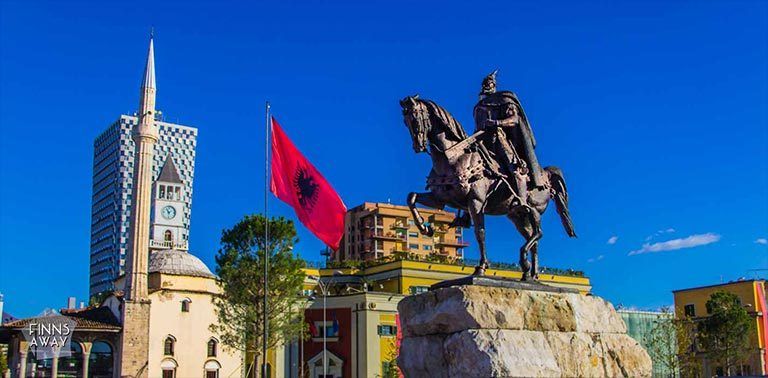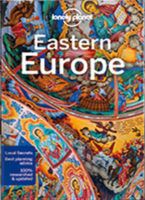
Nomad life in Tirana, Albania
Our visit to Tirana, the capital of Albania in the Balkans, Eastern Europe, is a good example how our current life style differs from holiday travelling. We stayed in the city for a whole week, but visited the center only twice to get to know the city a bit, and to see the main sights. Other days were filled with working on the blog and social media channels, and doing some sports.
Before this nomad life style we never stayed this long in one location on our travels, and holiday trips were packed with all-the-things-you-need-to-see-and-do. Nothing wrong with that, it was a traveling style that enabled us to see a lot during our holidays, but thinking back now, we were super busy to run from one place to another. Like when we were on our Balkan tour back in 2012; visiting Albania meant a ride from southern Macedonia to Tirana, staying one night there, taking a bus north and staying another night in city of Shkroder close to the border of Montenegro. You can’t really build a full picture about a country or city in such sort time. So it’s no wonder that Tirana didn’t impress us much back then, it just seemed an undeveloped and grey capital city.
From Pristina to Tirana
So now it was time to visit the capital again, and give it a new chance before heading to the coast. We drove to Albania from Kosovo through beautiful, mountainous landscapes. The weather had been cloudy and chilly, but when we got down from the mountains and closer to Tirana, it got a lot warmer. Crossing the border was once again very quick process, just one check for passports and car registration documents.
Roads in Albania were mostly in surprisingly good condition, and it was an easy drive to Tirana. But in the city the traffic is somewhat chaotic; the roundabouts are crazy full of cars, finding a free parking space is almost a mission impossible and the local driving style is a bit aggressive or at least reckless. So it takes some nerves to drive in the center, but when staying cool and readjusting your driving style a bit, it’s fully doable.
We had booked accommodation beforehand via booking.com. We found the apartment easily, but had to drive around the quarter and along narrow one-way streets quite some time before finding free parking space. Finally we got lucky, and found one free spot just in front of the house. Centrally located Tirana Rooms is a nice big 7th floor apartment house with three rooms for rent. We chose the one with private bathroom, and only shortly met with other guests that stayed a night in another room. Big kitchen was perfect for cooking and there was a huge balcony with views over the city.
Sightseeing in Tirana
When heading to the city center, we quickly noticed that it has changed a lot during five years. There was huge amount of pretty cafes and street side restaurants with terraces and the atmosphere was lively. Seems that the city has seen quite some renovations, which of course is a common trend in quickly developing Balkan countries. The huge central square, called Skanderbeg Square, has been renovated, or actually it was partly still under renovations. We hardly recognized it to be the same exact spot where we took some pictures five years back. The main sights around the square are National History Museum, National Opera, Et’hem Bey Mosque and Clock Tower. And of course the huge Skanderbeg Monument that commemorates the national hero of Albania.
One completely new sight in Tirana is the Great Mosque that was still under construction, but already a building of jaw-dropping majesty and beauty. When ready, the Mosque complex, that is called Namazgja, will be the biggest Islamic center in the Balkans. The huge construction project has a price tag of 40 M€ and is mostly funded by Turkish government.
Close to the mosque is another popular sight, the 18th century Tanner’s Bridge that has been re-constructed and is now in pedestrian use. The handsome stone bridge used to be part of St George Road that linked Tirana with eastern Albania highlands. There is a new pedestrian route, called Murat Toptani Street, leading from the bridge towards the main square. It goes past several sights like the Fortress of Justinian (ruins of Tirana Castle) and there are plenty of cafes and restaurants along the street.
For those interested in running and walking in parks, we can recommend the Grand Park of Tirana (Parku I Madh Kodrat e Liqenit). It is a big green area south of the city center, with an artificial lake and footpaths with nice views. There are also some landmarks and sights like the Church of St Procopius and the Presidential Palace. The park is popular among the locals, but still peaceful compared to the bustling city. Strolling along the footpaths offers some fresh air, which is very welcome after the city streets filled with exhaust fumes.
Facts and historic milestones of Albania
- Total population of the country is around 3 million people, out of which 800 000 lives in the capital Tirana.
- Borders with Mediterranean Sea (Adriatic and Ionian Sea) in the west, Montenegro in the northwest, Kosovo in the northeast, Macedonia to the east and Greece to the southeast.
- Proclaimed independence from the Ottoman Empire in 1912. Was militarily occupied by Italy 1939-1943 and shortly by Germany after that. Albanian Communist Party was founded in 1941 and after the second World War Albania became a communist state.
- People’s Socialist Republic of Albania ruled from 1946 to 1992. During that time travel and visa restrictions made Albania pretty much closed from tourism, and it was one of the most difficult countries to travel to or from.
- From 1950 to 1985 around 700 000 concrete bunkers were built all over the country for defend purposes. These concrete domes can still today be spotted around the country.
- In 1961 the country broke of diplomatic relations with USSR and reoriented itself towards the People Republic of China. In 1966-67 Albania experienced a massive cultural and ideological revolution. Relationship with China lasted until 1978 and the communist regime collapsed in 1990.
- Since early 90’s, Albania has developed closer tights with Europe, has been a full member of NATO since 2014 and has applied to join the European Union.
- Today’s Albania is a developing Balkan country with economy dominated by service sector, industry and agriculture.
- Tourism is increasing, in 2016 Albania welcomed 4,74 million visitors.
Have you considered Albania as a holiday destination?
Coming up next: posts about the beautiful coastal cities of Albania






